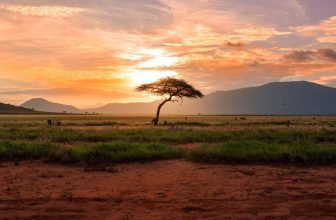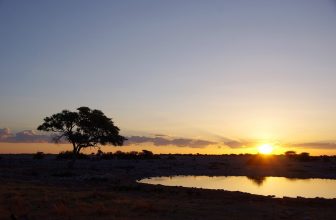
Animal horns have been used in various cultures across the world for centuries. From being blown into as a warning signal to being ground and used as a medicine, animal horns are a part of many traditional groups. And while these traditions should be honored, they have caused a multitude of extinctions and increased poaching problems around the world.
Animals use their horns for many things. They are most commonly used for defense against predators and fighting among their own for territory and dominance. Remembering that horns are far more useful on the animal then off, keep reading to find out about the most notable horns found on African animals.
What Animals Have Horns?
There is a difference between horns and antlers. The true definition of a horn is only found in Bovidae animals, e.g. cows, water buffalos, African buffalos, and yaks. A horn is a keratin sheath over a bony structure. Horns grow out of the animal’s head and are a permanent, two-part formation of the animal that often continues to grow.
Antlers are different because they are found in the Cervidae family, e.g. deers, moose, and elks. Antlers branch out and are normally shed annually, growing back during mating season. Antlers are not made up of keratin and only consist of bone.
Names Of Animals With Horns
Most of the horned animals in Africa are a part of the antelope family. Rhinoceros and Giraffe are also popular horned animals, although technically their horns do not fit the exact definition. Keep reading to find out how they differ.
Spiral/Curly Horns
Spiral horns are impressive! As the name suggests the horns are spiraled and resemble a corkscrew. The antelope animals that fall into this category in Africa are referred to as the ‘bushbuck tribe’, or the more scientific term, Tragelaphini.
The most notable of these antelope are the Bushbuck, Eland, and Kudu.
Bushbuck
Bushbuck are the only African antelope that do not live in herds. Bushbuck are solitary, non-territorial animals who find safety from predators alone in the thick foliage, mainly around water sources.
Eland

The giant eland and common eland are the biggest and second-biggest antelope in the world respectively. The two types of eland differ only slightly in size and coloring. However, both the giant and common eland, as well as both sexes, display a magnificent set of V-shaped spiral horns. The eland is the most famous of the spiral-horned animals.
Kudu

The greater kudu definitely boasts one of the grandest pairs of horns. On average, they are an impressive 48 inches in length (122 cm) and average two and a half twists in the length of the horn. Kudus are tall, large antelopes and are always very exciting to spot.
Straight Horns

The most memorable straight horned animal in Africa must be the gemsbok (Dutch), a part of the Oryx family. Gemsbok are distinguished by their light greyish-tan coloring and black and white facial markings. Their spectacular horns are an average of 33 inches (85 cm) in length and are almost perfectly straight.
Females have only slightly thinner, longer horns than males, and are often mistaken for males. Female gemsbok mainly use their horns to protect their young from predators, while males use their horns to defend their territory.
Small Horned Animals
Although smaller animals have smaller horns, their horns are still used for the same purposes as larger horned animals. Below are some cute, famous, and little antelopes.
Dik-Dik

The dik-dik is an adorable antelope. They have their name because of the whistling warning calls both the males and females make.
Only the males have horns which average 3 inches in length (8 cm). The dik-dik species are some of the smallest antelope in the world.
Springbok

The springbok is South Africa’s national animal and the name of the national rugby team. While their horns are fairly large in ratio to the size of the antelope, they are relatively small compared to other horns found on the animals in Africa.
Springbok get their name because of their distinctive jump while moving at a fast pace. All four of the springbok’s hooves are off the ground and their legs are stiff when they spring into the air.
Both males and females have horns. Their horns average 14-20 inches in length (35-40 cm). The springbok horns curve inwards and lean backward from their head.
Large Horns
The larger animals with horns show off some very impressive and unique horns.
Cape Buffalo

The Cape buffalo (also known as water buffalo) is a large animal with horns. The horns on the Cape buffalo can grow so big that they can sometimes fuse together into one horn in the center. Both male and female buffalos have horns, although the female’s horns are significantly smaller.
The Cape buffalo is one of two horned animals in the Big-Five. The second is the rhinoceros.
Rhinoceros

Rhino horns have made international news due to the devastating poaching around them. The rhino horn technically does not fit the definition of a horn. Rather than resembling nails (made from keratin), they resemble hooves and beaks. Although there is a difference they are still referred to as ‘horns’.
The rhino horn can grow up to five feet long (over a meter and a half). They are impressive to see and should only be seen in the wild or on protected rhinos.
Are There Animals With Antlers in Africa?

There are no animals with antlers in Africa. Antlers are predominantly found on deers in North America. Because antlers shed, hikers and outdoorsmen can unexpectedly find them in the wild and can take them home to keep.
Types Of Goats With Horns

Most goats in Africa are farmed or domesticated. Goats are a part of the Bovidae family and generally, both males and females have horns. While most types of goats have horns, there are species of goats that are naturally born without horns. These species are known as a “polled” goat.
Are Giraffe Antlers Horns?

While the general public call the protrusions on a giraffe’s head ‘horns’ they are technically called ossicones. Ossicones are made up of cartilage and covered in skin and hair. It is unsure why giraffes have ossicones as they use their long necks to fight.
Cool Animal Horns

Horned animals can be found all over the world. Below is a magnificent horned animal list, most of which can be found outside of Africa.
- Bukharan markhor
- Alpine ibex (long-horn goat)
- Sable antelope
- Pronghorn antelope
- Addax
- Blackbuck
- Chousingha (four-horned antelope)
- Manx Loaghtan
Closing Thoughts on Horned African Animals
Horns can be spectacular and breathtaking. They can also be rare. Africa has some of the most majestic horned animals in the world.
Unfortunately, this has resulted in some species becoming extinct. Poaching is done predominantly for meat consumption, trophy hunting, and cultural demand and status, especially with regards to tusks and horns. Poaching has put the rhino and addax in ‘critically endangered’ status.
Admiring these animals is encouraged and the best way to do this is on safari, drinking a beer, and marveling over the animals in their natural habitat at sunrise or sunset. That sounds like a pretty special experience!






